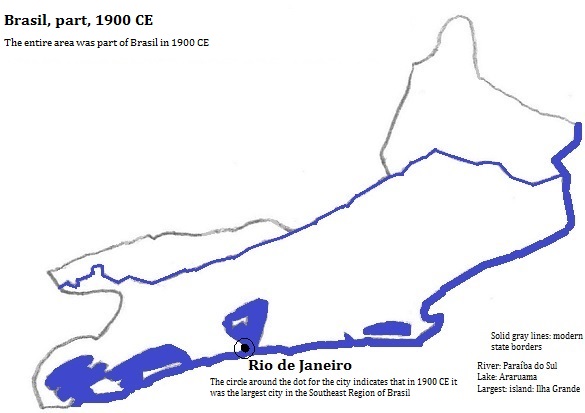Rio de Janeiro
Rio de Janeiro1, 'Rio' for short, is on a bay with Sugar Loaf Mountain behind it. It has a metropolitan population of 12.4 million, with 6.4 million in the city proper.2 It is is one of the world's chief tourist destinations, with suburban Copacabana (including the Capacabana Palace Hotel) the most famous destination, and Carnival its biggest drawing festival. Lesser known attractions include a meteorite in a museum weighing over 5000 kg. Towering over the city is a status of the Christian man-god, Jesus, called Christ the Redeemer. A soccer (football) stadium, nicknamed Maracana Stadium but formally called Mario Filho Stadium (estadio) can seat nearly 180 thousand. Not so enormous is the 1909 Teatro Municipal, inspired by the Paris opera house (Palais Garnier). Currently the tallest building is the 48 story Rio Sul Center.
The city itself and nearby Septetiba are important ore ports.3
Two busy airports are Rio de Janeiro-Galeão International and Santos Dumont.
| Year | Population | Political entity |
| 1700 CE | 20,0004| Reino de Portugal e Algarves | |
| 1800 CE | 44,0004| Reino de Portugal e Algarves | |
| 1900 CE | 744,0004| Brasil | |
| 2000 CE | 11,209,000 (metropolitan)2| Brasil | |
External references
Skyline at night including Sugar Loaf Mountain
Historical Maps



Footnotes
1. Translated into English: 'River of January or January River.'
2. world-gazetteer.com, accessed 12/2/2012.
3. Alastair Cooper, ed., The Times Atlas of the Oceans (Van Nostrand Reinhold Company, 1983), "commodity loading ports" map.
4. Tertius Chandler, Four Thousand Years of Urban Growth, 2nd ed. (The Edwin Mellen Press, 1987), "Tables of World's Largest Cities". Rio de Janeiro was the largest city in the Southeast Region of Brasil (Brazil) in 1700, 1800 and 1900.


